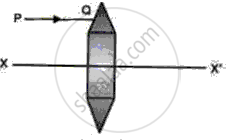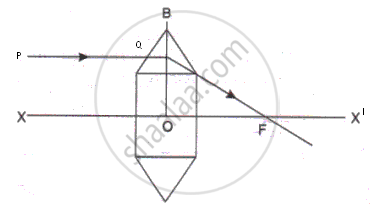Advertisements
Advertisements
Question
Fig shows a lens as a combination of a glass block and two prisms.

(i) Name the lens formed by the combination.
(ii) what is the XX' called?
(iii) Complete the ray diagram and show the path of the incident ray PQ after passing through the lens.
(iv) The final emergent ray will either meet XX' at a point or appear to come from a point on XX'. what is the point called?
Solution
(i) Convex lens
(ii) The line XX' is calledf the principal axis.
(iii)

(iv) The final emergent ray will meet XX' at a point called its principal focus of the lens.
APPEARS IN
RELATED QUESTIONS
State the dependence of angle of deviation On the refractive index of the material of the prism.
Light passes through a rectangular glass slab and through a triangular glass prism. In what way does the direction of the two emergent beams differ and why?
How must light travel out of a substance if it is not going to be refracted?
How does the angle of minimum deviation produces by a prism change with increase in :
the wavelength of incident light
What is the refractive index of water
A coin placed at the bottom of a beaker appears to be raised by 4.0 cm. If the refractive index of water is 4/3, find the depth of the water in the beaker.
The diagram below shows two parallel rays A (Orange) & B (Blue) incident from air, on air-glass boundary.

- Copy and complete the path of the rays A and B.
- How do the speeds of these rays differ in glass?
- Are the two refracted rays in glass parallel? Give a reason.
What is lateral displacement?
